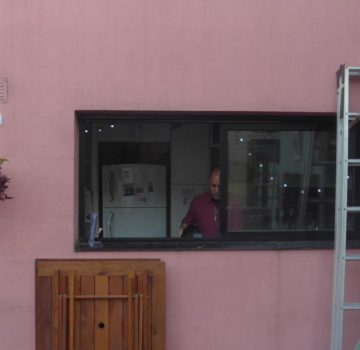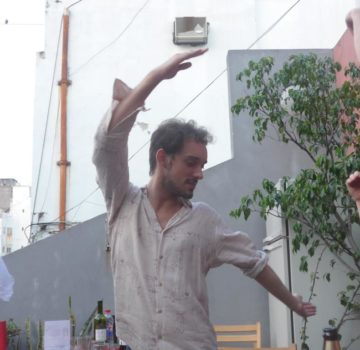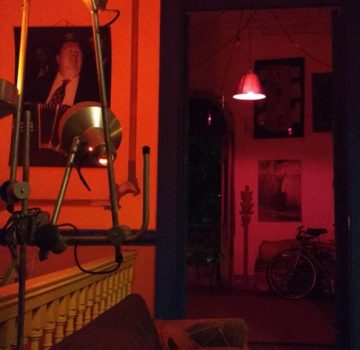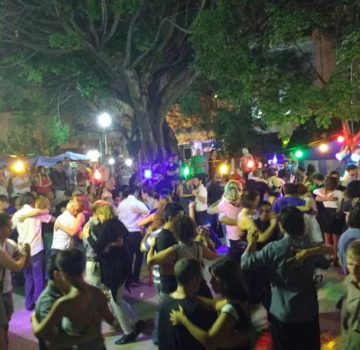
Tango schon wieder
März 2, 2016
und zwar weil ich das viel zu wenig ausgefuehrt habe und auch immer noch zu wenig gerade historisch weiss.
Also vergessen zu erwaehnen habe ich auf jeden Fall, dass ich seit Dezember selbst Tangosuechtig geworden bin und viel tanzen gehe. Und dass mein Tanzschuhpaeckchen noch immer nicht eingetroffen ist. Noch immer nicht. Seit Mitte Dezember. Gar nicht zu erwaehnen die vielen leckeren Suessigkeiten! Die Argentinier wuerden dazu nur gelassen mit den Schultern zucken und sagen: Argentina…
Genau, so ist das naemlich. Post ist hier sauteuer und dauert eeewiiig. Nunja, damit koennen die meisten hier natuerlich sehr gut leben, weil sie sie quasi niemals brauchen. Aber genug davon und mehr ueber Tango.
In Buenos Aires gibt es unheimlich viele und schoene Milongas. Jede Milonga je nach Stil hat natuerlich auch ein dementsprechend anderes Publikum. Manche Milongas sehen aus wie grosse Ballsaele und kosten 100 Peso Eintritt, andere sind komplett a la gorra (in den Hut also nur fuer Trinkgeld) und sehen alternativ eingerichtet aus und sind klein und man findet kaum die Tuer und trotzdem gibt es einen Showtanz und eine Klasse davor.
Tango AGAIN. Because you and I know way to little about it. No, I just want to talk some more about my passion. The thing is that I became addicted around middle of last december am dance nearly every night since then. Except for all those vacations that are most important of course. My christmas and dance shoe package still didn’t arrive. Which makes me have to buy new dance shoes. Stupid mail.
There are plenty of Milongas (Tango bars) in Buenos Aires and they are all different. And depending on style and ambience different people visit different places. Obviously. Some look like ballrooms and cost around 100 Peso others are completely free (for tips, a la gorra) more alternative and hidden so well that you need to know where to find the door. And there even still might be a class and a showdance…
Wenn man tanzen geht, ist es ueblich, dass der Mann die Frau zum tanzen auffordert, ausschliesslich mit Augenkontakt. Diese Art nennt sich „Cabeceo“.
Oder wenn man so bloed ist und es nie rafft, dass man gerade afugefordert wurde, wie ich den ersten Monat lang, dann kommen sie auch gerne mal vorbei und fragen: Bailas? (Tanzt Du?). Wenn man befreundet ist, kann man als Frau auch den Mann einfach auf die Tanzflaeche zerren und natuerlich kommt es auch ein bisschen auf das Ambiente an. In den Alternativeren Milongas sieht man auch Leute, die die Frau tanzen einfach auf FuehrerInnen zugehen und sie auffordern. Allerdings ist das nicht die elegante Form und oft spricht man unbekannterweise nicht ein Wort bis zum Ende der ersten Tanzes oder gar der ganzen Tanda.
Eine Tanda, das ist ein Zirkel von 4-5 Tangos. Das ist nicht genau festgelegt, aber meistens so. Es sind fast ohne Pause nacheinanderfolgende Stuecke des gleichen Stils. Normalerweise folgt dem eine Cortina. Eine Pause von ca. 30 Sekunden zum zurueck zum Tisch kehren oder sich gleich wieder auffordern lassen. In dieser Cortina wird oft komplett andere Musik gespielt. Rock, Punk, Folklore, Pop, irgendwas. Wenn es Salsa, Rock’n’Roll oder Chacarera (Folklore Argentina) ist, dann auch gerne mal das ganze Lied und dann wird auch aufgefordert.
The classic way for a man to ask a woman to dance works with eye-contact. It’s a simple gesture maybe a movement with the head or even hand called „cabeceo“. This also still is the most common way even though it depends on the milonga.
Also I have been stupid enough to not notice having been invited for about a month at least. Those leaders realized it often enough and come over to directly invite you or to ask: Bailas? (Do you dance?) Of course you might know each other and one will just pull the other to the dancefloor or in my favorite and more alternative Milongas the follower might ask the leader. Most typical though still is the eye thing and it happens that you don’t talk a word until the end of the first song or even the whole tanda.
What is a tanda? A circle of about 4-5 Tangos. It’s not always the same number depending on Milongas and songs. Those pieces usually run even without a break until the cortina – which is the break between two tandas. It’s a random song, could be rock, punk, folk, pop (or whatever the milonga operator likes) playing for 30 seconds. Sometimes people play the whole song, especially if it is salsa, rock’n’roll or chacarera (argentinian folkmusic – more later) because people will dance to it, too.
Wenn man nicht aneinanderklebt, wie manche Paare, die zusammen sind es tun, tanzt man eigentlich nie zumindest nie unmittelbar zwei Tandas hintereinander mit dem selben Partner. Spaeter dann vielleicht nochmal. In manchen Milongas gibt es keinen DJ oder ab einer bestimmten Uhrzeit nicht mehr, dann uebernimmt der PC das und es gibt keine Cortina. Es gibt aber immernoch Tandas und man muss quasi selbst hoeren, wann der Stil sich aendert. Das kann auch nur von sehr altem Tango zu etwas weniger altem Tango sein und ich hoere das garantiert nicht immer. Aber dann entscheidet man einfach zusammen ob es jetzt reicht.
Denn es ist sehr unhoeflich SEHR unhoeflich einfach jemanden innerhalb einer Tanda zu verlassen. Wenn das jemand tut ist es normalerweise ein/e AnfaengerIn, der nicht weiss, dass man eine ganze Tanda tanzt oder (eine akzeptable Version) man hat die Anzahl zusammen vorher abgesprochen ODER – und das wird man deutlich sehen – einer von beiden mochte den Tanz so ganz und gar nicht.
Vielleicht hat einer ausversehen eine/n Anfangerin erwischt und ist unzufrieden mit dem Niveau des Tanzes. Das waere die sehr arrogante Version, jeder muss schliesslich lernen und man merkt ja sehr schnell, welches Niveau die andere Person hat. Eine Tanda kann man durchaus ueberleben ist meine Meinung – ganz abgesehen davon, dass der einzige Grund aus dem Tanzen Spass macht auf keinen Fall ist, dass jemand gut tanzen kann. Eine zweite Variante waere also dementsprechend, dass das Physische oder die Chemie nicht stimmt. Fuer mich spielt da die Groesse ganz stark eine Rolle, da viele Maenner hier sehr klein sind und es sicher nicht unmoeglich, aber deutlich schwieriger ist, wenn der Groessenunterschied sehr stark ist. Am Afang war das sehr schwierig fuer mich, mit mehr Erfahrung wird das unglaublich viel leichter.
Man sieht viele FolgerInnen, die versuchen sich anzupassen (Ich auch am Anfang!) und dementsprechend eine ganz falsche und ungemuetliche Tanzhaltung einnehmen. Damit ist der Tanz schon automatisch unbequem und das drueckt sich natuerlich auch auf die Stimmung dabei aus. Gerade bei so einem sensitiven Tanz, bei dem es nur ums Hoeren und Fuehlen geht, muss man sich einfach wohl feuhlen um das auch im Tanz auszudruecken. So kann es eben auch sein, dass man ein aehnliches Tanzniveau hat, aber es einfach nicht passt oder man sich unsympathisch ist.
If you’re not glued together like some couples seem to be, you’re not dancing two tandas in a row with the same partner. If it was very nice and both enjoyed it it’s very likely one or the other will ask again later. At some milongas there is no DJ at least not anymore to a certain time. In that case there is no cortina because the computer just puts tanda on tanda.
For me especially in the beginning it was really hard to hear when a tanda ends then. Because there might be an outrageous or very slightly change of style and you just got to hear it. But it’s also very likely to just decide how many dances you want to do, together. Talking about Does and Don’ts – it is very impolite to leave your partner before the tanda is ending.
One very common reazon is one of the two is a beginner and simply doesn’t know which is pretty excusable. Another thing as mentioned is if you talk about it before or while dancing. That for example happens to me when I am really tired and about to go home but don’t want to reject the offer. The third and really unfriendly option is that one of them didn’t like the dance at all.
Reasons here could be that the levels are very different. For me that would not be a reason since everybody needs to learn and I find it kind of arrogant to not bear this for only 4 songs besides that only being a good dancer is not what makes it amazing to dance with someone.
A second reason might be the physical or chemistry between two people. Since I am very tall in comparison to most argentinians this was a real problem for me in the beginning. With more experience though I realized it is very possible. I still see a lot of following people that try to adapt to the short person’s hight and sometimes the leader tries to make you his size (haha). This puts myself into a very uncomfortable and unstable position and can’t be healthy for your back.
Unfortunately the dance altogether already doesn’t feel very relaxed which affects the atmosphere. Especially since tango is such a sensitive dance, expressed through how you receive the music and the connection to your partner – it is very obvious (posture, face) if you enjoy it or not. Therefore it happens that you have a similar level but simply don’t fit together somehow because the feeling isn’t right.
Womit wir beim letzten und leider nicht so seltenen Grund waeren, einen Tanzpartner zu verlassen: Er ist nicht da, um Tango zu tanzen. Er macht unangemesse Kommentare, fragt einen bescheuerte Dinge, versucht nach der Tanda zu kuessen oder bleibt danach am Tisch, um zu reden, obwohl es einem sichtlich unangenehm ist. Es gibt auch ohne all diese Dinge einige Maenner, die einem auf eine Art und Weise ein sehr unangenehmes Gefuehl beim Tanzen geben und fast immer folgt dann irgendwas, was einem Recht gibt. Und es sind nicht nur Argentinier oder nur Touristen, nicht nur Alte oder nur Junge… wie immer betrifft das quasi jeden ein bisschen. Wobei mir diese Verhaltensweise nur von Maennern bekannt ist, bis jetzt. Das ist das Traurige, dass es leider immer Menschen gibt, die Koerpernaehe gleich sehr sexuell sehen und es nicht voneinander unterscheiden koennen.
The last and sadest reason to leave your partner during a tanda is not unexpected: He didn’t come to dance tango. He makes weird, inappropriate comments, asks stupid questions, tries to kiss you or simply escorts you back to your table and stays there to talk (also counts as a DON’T if not explicit) even though one obviously feels uncomfortable.
There are also men making you feel very uneasy just with dancing in a certain way without saying anything. Mostly something weird is following to that. Of course this is not only Argentinians/tourists/young/old/whatever – however, unfortunately in my experience only men. It makes me very sad that there are people not being able to disconnect closeness and sexual vigor.
Es kann also genauso eine Frau sein, die den Mann tanzt oder ein Mann, der eine Frau tanzt. So sieht man durchaus gemischte Paare, bei denen die Rollen getauscht sind oder natuerlich gleichgeschlechtliche Paare oder Paare, die unglaublicherweise mitten im Tanz die Fuehrung wechseln. Genaugenommen koennen alle sehr guten TaenzerInnen beide Rollen tanzen und auch ich wuerde sehr gerne bald Fuehren lernen. Ich wuerde mich auch total freuen, wenn viel mehr (sich als „hetero“ bezeichnende) Maenner die gefuehrte Rolle lernen wuerden, das waere so eine Art Beweis, dass die Gesellschaft die weibliche Rolle als schwach und devot zu sehen, ueberwunden haette, . Das wuerde ich gerne noch weiter ausfuehren, wuerde jetzt allerdings zu lang. Mal abgesehen davon, dass mir beide Rollen viel Spass machen, ist es fuer mich anspruchsvoller „den Mann“ zu lernen. Ich hoerte, dass original der Tango ausschliesslich von Maennern getanzt wurde. Doch auch hier habe ich keine weiteren Infos zu.
Der Aufbau einer originalen Milonga scheint mir ganz schoen kompliziert. Die viereckige Tanzflaeche in der Mitte und sich gegenueber sitzend, durch die tanzende Menge hinweg anstarrend quasi, die Frauen auf der einen Seite und die Maenner auf der anderen. Nun ist allerdings das schon weiter weg und dann kann es dochmal passieren, dass sich die falsche Frau von Blicken durchbohrt fuehlt und sich zum Tanze erhebt. Denn sie sass vielleicht genau hinter der Gemeinten. Dann muesste der Gentleman sozusagen einer sein, um sie nicht zu blamieren und die andere damit veraergern. Was fuer eine schreckliche Atmosphaere. So ist es nicht mehr, getrennt ist keiner und alle sitzen an Tischen und trinken etwas, meistens Wein und Bier. Fast immer gibt es Empanadas und fast immer Pizza, wenn man moechte. Oft Rund um die Tanzflaeche aber auch in separaten Zimmern. Oder man steht gar herum.
Back to the beauty of tango. As kind of mentioned it doesn’t have to be a woman being following or a man being leading. This leaves all combinations sprout. Different sex, same sex and all constellations. Particularly impressive to me are those couples that change the lead in the dance.
All excelent dancers I met so far can dance both parts, it is very important to understand the other role if you want to be very good no matter what you prefer. I myself would love to see more men that consider themselves „hetero“ in the following position since it would mean some sort of overcoming the following role as „weak and female“. It is not supposed to be a suppression being lead and if nobody would see it that way there would be a lot more men following, I am very sure of that. I still do have a problem with that kind of perception but this would go to far to explain right now. Anyway I really want to learn to lead (I think it is harder to learn) and guess that I would like both roles equally just as I never can decide for one thing in my life.
I heard that originally tango was danced by two men. I don’t have any further info to that.
A milonga in the tradicional composition seems to be pretty complicated to me. There would be a square-shaped dancefloor in the middle. And on each side across from each other seats for women on one and for men on the other side. This means that the men would have to „stare“ at women through the dancing crowd in the middle to invite them to dance. That could be really far away and the wrong woman might lift elegantly. So that the gentleman would have to not embarrass her and at the same time displease the summoned lady.
Well this does not correlate with a milonga anymore. Luckily. There is no separation, people are sitting together and drinking mostly wine or beer. Usually the atmosphere is joyous and people eat Empanadas or Pizza, stay, sit or dance and talk.
Exkurs Castellano:
Nebenbei bemerkt ist Argentinien so informell, dass man eigentlich nie Siezt. Auch niemanden bei der Post. Nichtmal Polizisten, zumindest nicht auf der Strasse. Dafuer ist hier das Castellano so anders, dass die Form fuer 3. Person Plural sie immer Sie ist, also Ustedes. Und fuer alle Spanischkenner die wissen, dass die 2. Person Plural vosotros WAERE jetzt wissen, dass das eigentlich NICHT GIBT und ebenfalls Ustedes ist.
Klingt jetzt verwirrend, ist es aber auch verdammt nochmal. Mir ist gerade erst wieder klar geworden wie anders es hier ist, nachdem ich selbst schon die ersten 2 Monate derart mit dem komplett anderen Sprachgebrauch kaempfte, bis ich die Bekanntschaft einer Barcelonarin machte (gibts das Wort) und herausfand, dass sie schon einen Monat hier ist und als Spanisch (und Catalanisch) aufgewachsener Mensch immer noch nicht verstanden hat, wie man hier konjugiert. Also nochmal fuer alle, die es interessiert. Sagen wir mal Bailar (tanzen) in Spanien (links) im Vergleich zu in Argentinien (rechts):
- Ich – Yo Bailo Yo Bailo
- Du – Tu Bailas Vos Bailas
- Er/Sie/Es – El/Ella Baila El/Ella Baila
- Wir – Nosotros/as Bailamos Nosotros Bailamos
- Ihr – Vosotros/as Bailais (Ustedes Bailan)
- Sie – Ellos/Ellas Bailan Ellos/Ellas/Ustedes Bailan
Hoefliche Form (formal address): Singular: Usted Baila (3.Sg) oder Mehrzahl: Ustedes Bailan (3.Pl)
Some freaky explanation about castellano:
Argentinia is known for being very informal. There is no one you would address to formal, not even police men as far as I noticed. The castellano used here is very different from the one I learned in school many years ago and also from Kansas City Community College’s castellano. I first realized how differnt and complicated it really is when even Laia from Barcelona after being here two month already still didn’t get how to use Ustedes. For everyone who wants to know, just look above, green is the spanish (also mexican?!) conjugation and red the Argentinian version. I think actually it’s used like this moreso in whole Latinamerica except for that other countries use the Usted (2nd person singular, formal you) a lot more.
Fast alle haben frueher oder spaeter Lifemusik, 1-10 Personen, mit und ohne Gesang. Eins der wichtigten und typischsten Instrumente ist jedoch das Bandoneon. Es ist dem Akkordeon sehr aehnlich, hat aber keine Tasten, sondern nur Knoepfe. Manche sagen, es kaeme irgendwie aus Deutschland, aber ich bin da nicht Faktenfest. Es scheint jedenfalls schwieriger noch zu spielen zu sein. Trotzdem spielen selbstverstaendlich auch viele Leute Tango komplett ohne.
Nauterlich gibt es auch im Tango alle moeglichen Arten von Tango. Erstmal gibt es ueberhaupt im Tango drei grosse Stilrichtungen. Das sind Tango, Milonga und Vals also Waltzer. Man hoert es ganz deutlich, wobei Milonga wohl die klassische Tangomusik war und wobei wenn man tanzen geht bei weitem am meisten Tango gespielt wird. Es gibt auch viele Leute, die sagen, sie tanzen Milonga total ungern oder Valse oder beides. Ich tanze alles sehr gern.
Auch hier poste ich jetzt nichts Verruecktes und weithin bekannte Stuecke. Zum Beispiel koennte man sich jetzt auf Youtube „Caminito“ (Diminutiv von Weg), „La Bruja“ (Die Hexe) oder „Asi se baila el tango“ (So tanzt sich/man der/n Tango). Sehr bekannt fuer Tango waere Piazzolla und das Thema Libertango eines der beruehmtesten und zaehlt als sehr modern.
Nearly all milongas have live music, could be one person or ten, sang or instrumental, yet, one of the most important instruments for tango is the bandoneon. It is very similar to an accordion but does only have buttons and no keyboard. I heard people say it came from germany but don’t know about that. It seems to be more difficult to play. There still are many ways to play tango without it. Within „tango“ there is a lot of different tango! Three style’s are differentiated: tango, milonga and vals. They sound very distinct. Milonga counts as the original music played in milongas, maybe that’s why they are called milongas (haha). Tango still is the most played style followed by milonga followed by… vals (surprise!). I like to dance all of them, unlike some people that don’t like usually either vals or milonga or both (kind of unfortunate if you wouldn’t like tango :P) I’ll give you some examples of rather known pieces, so nothing too crazy. If you want to check it out on youtube: „Caminito“, „La Bruja“ or „Asi se baila el tango“ are rather knownand classic tangos. This one is „Libertango“ by Piazzolla, very famous but modern:
Milonga ist froehlicher, weniger dramatisch als Tango und deutlich schneller. „De mis Amores“ oder „Arrabalera“ sind bekannt:
Milonga is very joyful and happy, less drama, less melancholia than tango and has quite a pace to it. Good examples are „De mis amores“ or here „Arrabalera“:
und dann ist da noch der Vals wie zum Beispiel dieser:
aaand this would be a vals:
Abgesehen davon, dass ich den klassischen Tango sehr gerne mag, gefallen mir auch elektronischere Sachen, es gibt sehr experimentellen Tango oder nur gesungengen. Alles moegliche. Sehr bekannt unter den neueren und anderen Tangos sind zum Beispiel das Gotanprojekt:
Besides that I do love classic tango, I also enjoy electronic or experimental tango. This one is also rather modern and new tango called by „Gotan Project“:
und Hugo Diaz mag ich auch gern:
Hugo Diaz:
Ich bekomme staendig zu hoeren, wie gut angeblich deutsche TaenzerInnen waeren, was mich wirklich erstaunt, da mir eigentlich als letztes Klischee von allen irgendeine tiefe Sinnlichkeit, Leidenschaft oder Romantik oder Beweglichkeit in den Sinn kommt, wenn ich an Deutschland denke. Nunja, jedenfalls bin ich auf die Milongas in Deutschland gespannt, wenn ich zurueck bin. Angeblich gibt es in Leipzig welche in Industriehallen… Jippie!
Abschliessend noch zu erwaehnen, der argentinische Volkstanz/musikstil ist auch ganz lustig, gerade zu tanzen. Jeder Tanz hat seine eigene Choreographie, quasi das Gegenteil vom Tango, bei dem alles improvisiert ist. Ich weiss einfach nicht, warum ausser Deutschland jedes Land zumindest irgendeine schoene Form von Volksmusik hat (Ja, es gibt schoenen Country, der nicht Pop ist!)
Oft ist eine Chacarera der Rausschmeisser am Ende einer Milonga oder es gibt zwischendrin eine Runde Chacarera. Das waere jedenfalls ein Stueck:
For whatever reason I often get to hear how amazing german dancers would be which really surprises me since I have a different stereotype in my head… sensuality, passion, romantic or elegant moves are simply nothing I connect to germany in any way. I heard about all the amazing (european and especially) german milongas though and am really looking forward to go dancing and destroy my prejudices. There are some in Leipzig in old industrial factories, I heard! Let’s hope nobody lied to me :)
Last but not least I need to mention argentinian folk music. It is really funny to dance and I like to listen to it. In this dance called „chacarera“ every single song has a choreography so contradictory to completely improvised tango.
I really would like to know why every single country has some sort of nice folk music BUT GERMANY. Yes, I did hear beautiful Country/Bluegrass! Chacarera is often the last song or even tanda played in a milonga to call it a night ;) … sometimes it’s also in between. This is a chacarera for you:
Auch der Tanz Chacarera ist absolut sehens und tanzenswert. Gut, dass immer so die Haelfte keine Ahnung hat, was sie tut und wann man jetzt kreuzt oder zurueckgehen muss und klatscht und schnippst und steppt und sein Roeckchen schwingt. Jedenfalls ist es immer sehr lustig, alle Lachen und ueberhaupt kommt mir das ganze doch sehr Nahe dem, wie ich mir Krebse beim Werbungsakt vorstelle. Also wenn sie tanzen koennten. Also der Paarungstanz. Das waere cool, wenn einer Steppschuhe und der andere ein Roeckchen anhaette.
Hier eine Version davon, wobei das normalerweise immer so viele Leute tanzen, dass man kaum mehr als eine Linie Platz hat und original bestimmt irgendwelche weiteren Roecke getragen werden, damit man die auch so rumwirbeln kann:
The dance chacarera is also fun to watch besides sooo fun to dance. Half of all people have no idea what to do and when you cross or step dance or clap or flip or swing your „skirt“. I love it, everybody’s laughing and doing something.
It really is the perfect impression of two crabs doing the mating dance for me. Here is a version that I like because people laugh and it seems authentic even both of them can really dance… in reality it’s always the whole dancefloor full of people dancing next to each other in a line:
Ich bedanke mich fuer eure Aufmerksamkeit, falls das tatsaechlich irgendjemande alles gelesen und sogar verstanden hat… sorry, ich mache nie Bilder beim Tango tanzen, gibts also nicht von mir. Ich habe einige schoene Videos von Musikern, aber alles auf dem Handy.
Achnee, ich habe ein paar wenige Photos zumindest von den Milongas und hier sind sie auch schon:
Thanks for really having read all that stuff (if you did!) and maybe even kept some of it… sorry, I never take pictures while dancing tango, one day maybe. I got some really nice videos from musicians but they are one my phone and I am the laziest person and so on and don’t know how to get it from there (yes, I am so old-fashioned). But at least I got some poor pictures of milongas for you:
Yuri Yuri:
Zona:
Plaza Dorrego:
Ciao Ciao!









